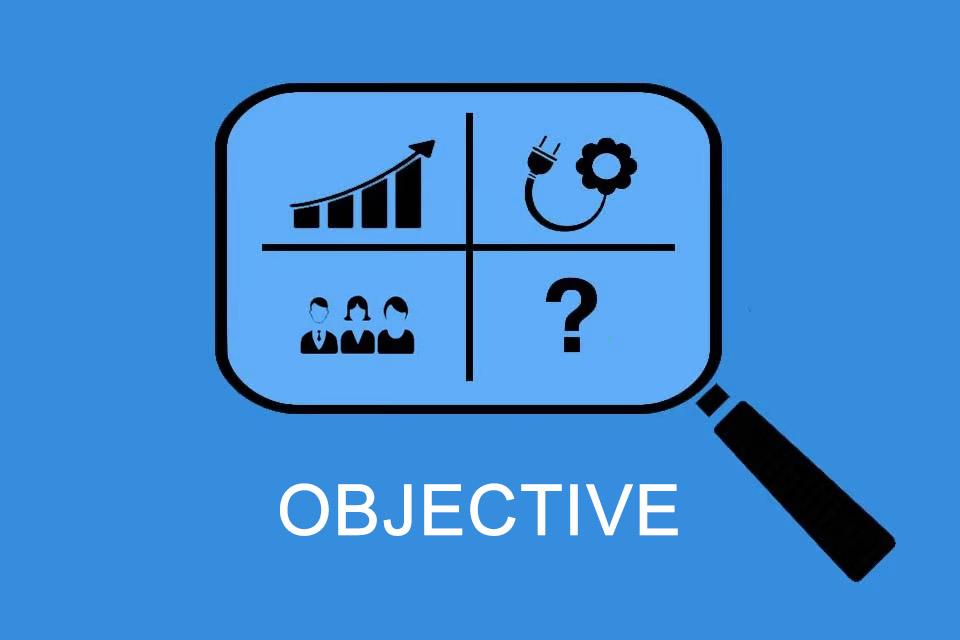What is an Objective?
Table of Contents: Definition – Meaning – Types – Wording – Questions from the field – Notes
Smartpedia: An objective describes a state in the future that differs from the present state and is desirable.
Objective – a desirable state in the future
An objective describes a state in the future which is different from the present state and is desirable. Objectives provide orientation for individuals and organisations, for society, politics, science, research or business and economics. This can easily be illustrated by a few examples:
- With Agenda 2030, the United Nations define 17 Sustainable Development Objectives for sustainable development.¹
- In economic terms, Germany is pursuing four goals: Price level stability, high employment, foreign trade equilibrium and steady and appropriate economic growth.²
- Companies usually define economic, sometimes also ecological or social objectives. These goals are both the basis for entrepreneurial action and the yardstick for measuring corporate success.
The meaning of objectives
In recent years, there has been increasing discussion about the importance of objectives. Do goals promote extrinsic motivation? Is intrinsic motivation the prerequisite for attractive objectives? What are the prerequisites for goals to have a positive effect on all participants and is this even possible? Do targeets possibly even restrict participants and developments, as they always follow an evolutionary development? The questions about the significance of objectives are manifold, as are the answers. As a suggestion, you will find some quotations on the topic below:
- “The path is the goal.” – Confucius
- “Only those who know their destination will find the way.” – Laozi
- “Many are stubborn about the path once taken, few about the goal.” – Friedrich Nietzsche
- “Those who have achieved all their goals have chosen them too low.” – Herbert von Karajan
- “I want to get an A on my maths test on Tuesday.” – Maria, 12 years old
What types of objectives exist?
Not only companies as a whole but also parts of companies, divisions or departments define and pursue goals. In addition, there are also project goals, development goals and also employees pursue goals. There are numerous ways and means of distinguishing between objectives:
Monetary and non-monetary or quantitative and qualitative objectives
Monetary goals are also referred to as quantitative or performance goals, since the respective performance can be clearly defined and measured, e.g. in terms of increasing profits (by x percent), increasing the return on sales (to y percent) or improving liquidity (to z monetary units).
Non-monetary or qualitative aims can be, for example, the increase in customer satisfaction, the improvement of the image or the increase in employee satisfaction.
It is interesting to note that the primarily non-monetary aims can also have a monetary influence: if employee satisfaction rises, the sickness rate of employees falls, the image improves, customers prefer to buy the company’s products more frequently. This perspective leads to the fact that, despite the formulation of ecological or social objectives, companies often have to put up with the accusation that they are ultimately only concerned with economic objectives.
Complementary, competing and indifferent objectives
These kinds of objectives are about the interaction with each other. If different objectives complement each other (increase employee satisfaction, lower illness rate and employee turnover), they hinder each other (low-cost production abroad and lower transport costs) or have no influence on each other.
Competing objectives are not uncommon in everyday business life, especially since different internal departments, departments or individual employees are in competition with each other. Therefore, in the course of stakeholder management, companies should also identify and analyse individual stakeholders with their motives and attitudes, and communicate with them regularly.
Main and secondary or overall and sub-objectives
Main objectives are more important than secondary objectives, so organisations primarily try to achieve their main objectives. The subobjectives are in a logical, hierarchical relationship to the overall objectives. They help to achieve the overall objectives.
It is important for organisations to reconcile the objectives of those affected. Target diagrams, which are often used to represent target hierarchies, can be used for visualisation purposes.
Strategic and operative or long-term, medium-term and short-term objectives
Short-term objectives have a time horizon of approx. 1 year, medium-term of 3 to 5 years and long-term of 5 to 10 years. The short-term goals are also regarded as operational goals (e.g. the relaunch of a website), the long-term as strategic objectives (conversion of drive technology in automobile production from gasoline and diesel to electric vehicles).
In the practice of enterprises it frequently comes to a mixture of the different kinds: A short-term, operational goal, can be a monetary main objective, which fights with another objective for internal human resources and financial resources. An operational, non-monetary target may be a sub-target that works in the direction of a monetary and strategic overall objective.
In addition to the types mentioned above, there are also behavioural objectives in organisations, for example, which aim at cooperation within the company and/or behaviour towards customers, partners or competitors. In response to questions about improved internal cooperation, there are often regular retrospectives, the definition of sprint goals, the use of good practices or the documentation of lessons learned.
The wording of objectives
There are various methods and approaches for formulating objectives. Here is a brief selection:
The SMART formula calls for goals to be formulated in a specific, measurable, attractive, realistic and time-bound manner.
The KRAFT objectives model³ recommends formulating undertakings in a concrete and meaningful way (konkret), realistically with their own test criteria and attractively in the sense of positive effects. Implementation skills (Fähigkeiten) and capacities are important here, as is clear scheduling. The main difference to the SMART formula lies in the consideration of capabilities (Terminplanung), although there are also opinions that the realistic formulation of objectives according to SMART also covers this point.
The SUCCESS formula is another acronym for goal formulation and stands for:
- Subjective – as personal as possible
- Urgent – what are the advantages of immediate action?
- Committed – commitment is the basis for achievement
- Concrete – as specific as possible
- Evaluate – a regular process for review
- Shared – publication contributes to achievement
- Support – secure the support of others
Two elements stand out in the SUCCESS formula: “Urgent” and “Shared”. Urgency and publication are not propagated in other alternatives to the formulation.
PACT stands for “Purposeful”, “Actionable”, “Continuous” and “Trackable”. The goal should be important for a long-term purpose and not for a short moment. A good goal is based on results that can really be controlled. Instead of planning for distant, future results, the focus should be on results in the present that are within the sphere of influence of an individual or an organisation. It is also important that measures taken to achieve a goal are simple and repeatable. And finally, it is about traceability, but not measurability; metrics are often overrated, while simple approaches that can be answered with yes or no are neglected.
To summarise briefly: There are different methods and approaches to goal setting, but there is no one approach that is suitable for every person, every organisation and every situation.
Questions in the context of objectives
Here you will find some questions and answers from practice:
Are Objectives and Key Results a method for formulating objectives?
Many companies today are faced with the challenge of operating in a complex world and therefore utilise Objectives and Key Results (OKR). OKR are made up of two components:
- Objectives are brief and precisely formulated inspirational descriptions of a desired objective state.
- Key Results are metrics that make both progress and target achievement measurable. As a rule, between 2 and 5 Key Results are formulated for each objective.
There is a decisive approach to formulation: each OKR is a description of a solution, an effective improvement or an impressive result.
In other words: Objectives and Key Results are measurable impact objectives conceived by the customer or market.
So while OKR are about objectives, the focus is not purely on formulating objectives, as is the case with the SMART formula or the SUCCESS formula, for example; OKR are primarily a framework for strategy implementation and employee management. To this end, it utilises short-term planning cycles, the limitation of the number of objectives and independent goal setting at team level with a view to the company’s aspirations. With these characteristics, OKR support the spread of agile principles throughout the organisation, although they are not themselves an agile target system or a method for formulating objectives.
What are Interrelations of Goals?
Interrelations of goals characterise the relationship and connection between goals. This is very important for organisations. An goal describes a future state that differs from the current state and is desirable. However, it rarely exists alone, but usually in combination or in an order with other objectives. There are relationships between the goals, the so-called interrelations of goals. They may contradict each other, they may be mutually exclusive, they may build on each other and there may be logical dependencies, or they may not influence each other at all.
Here you can find more information about interrelations of goals.
What is a Conflict of Objectives?
A conflict of objectives exists when individual objectives contradict each other in part or as a whole and therefore cannot be achieved in full. In other words, there is a competing relationship between the goals – also known as goal competition. The desirable, positive counterpart is a compatible target relationship.
Conflicting objectives are nothing unusual in business practice. Wherever people meet and pursue different interests based on their values, motives and ideas, conflicts are the order of the day. The exciting question is therefore: How can conflicts of interest be resolved as smartly and sensibly as possible?
Here you can find more information on the types of conflicting objectives and ways of resolving them.
What is a Goal Diagram?
A goal diagram visualises goals, relationships between goals and relationships between stakeholders and goals. Goal diagrams – also known as goal models – help to easily recognise relationships and derive requirements from the stakeholders’ goals.
Important: A goal diagram describes a snapshot that documents an assessment of the goals, the dependencies between the goals and the prioritisation by the stakeholders. It is a representation that should be checked cyclically to ensure that it is up to date in order to guarantee the long-term alignment of a development with the stakeholders’ objectives.
Here you can find more information on goal diagrams.
What are anti-goals?
Some publications speak of anti-objectives or anti-goals. These are formulated when selected aspects hinder the achievement of a goal.
Problem: You have to deal with too many issues at the same time.
Anti-goal: Agreement on a limit for activities (WiP limit).
In retrospectives, these anti-goals are often collected under the heading “Things we will refrain from doing in future”.
Is an objective merely a hypothesis of the future?
Notes (partly in German):
[1] Nachhaltigkeitsziele der Bundesregierung
[2] Gesamtwirtschaftliches Gleichgewicht durch magisches Viereck, https://www.destatis.de/DE/Themen/Wirtschaft/Volkswirtschaftliche-Gesamtrechnungen-Inlandsprodukt/magisches-viereck.html
[3] The KRAFT objectives model was developed by Gabrielle Müller, who works as a systemic coach.
If you like the article or would like to discuss it, please feel free to share it in your network. And if you have any comments, please do not hesitate to send us a message.
Here you will find additional information from our t2informatik Blog:



